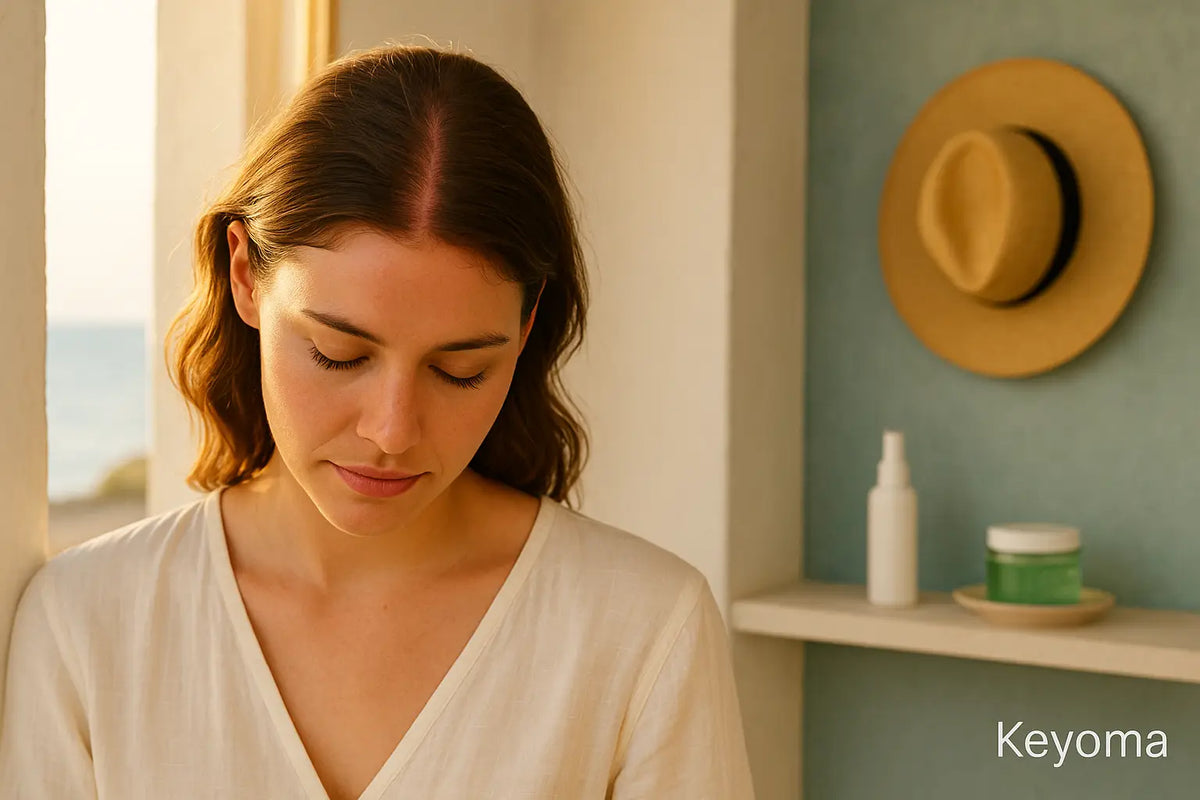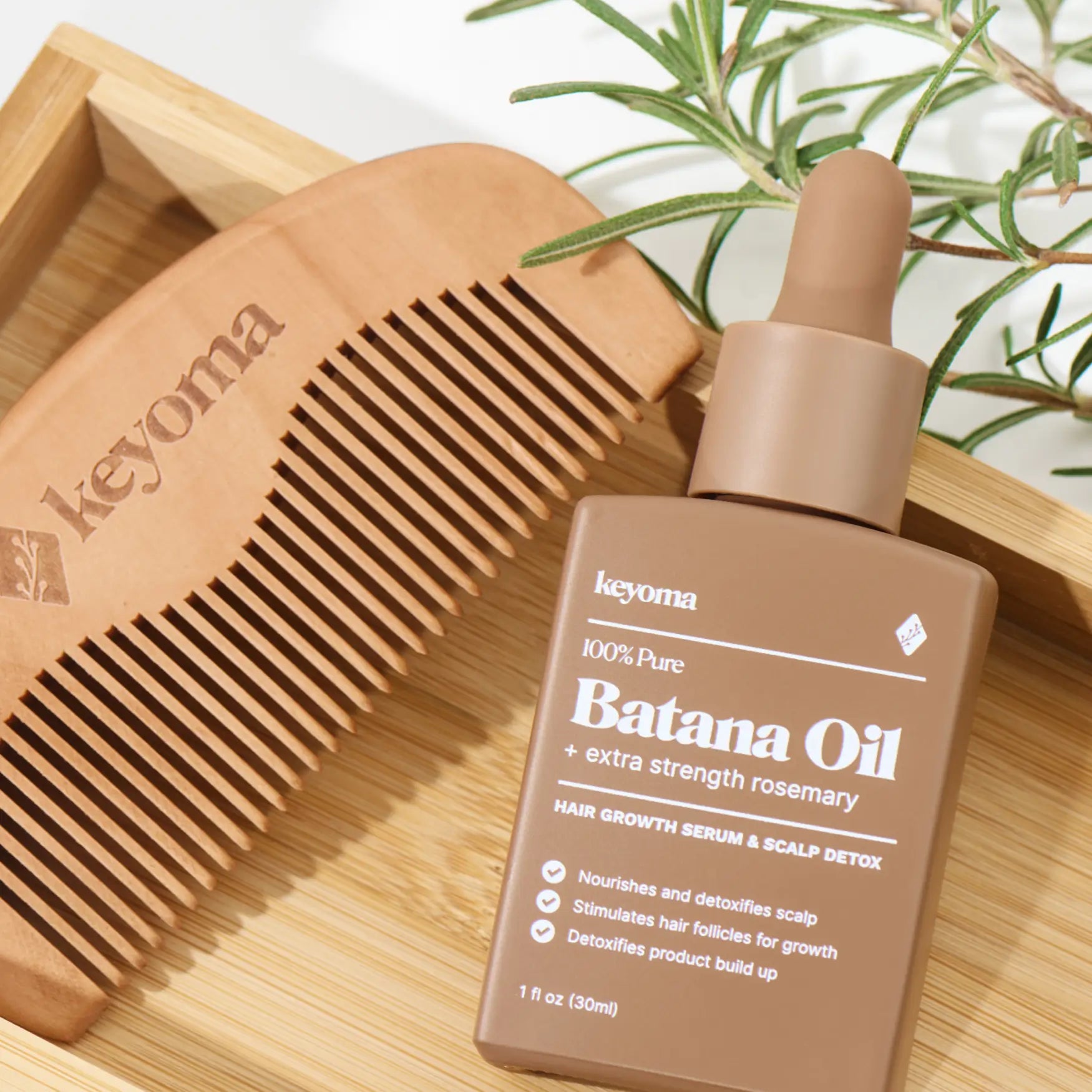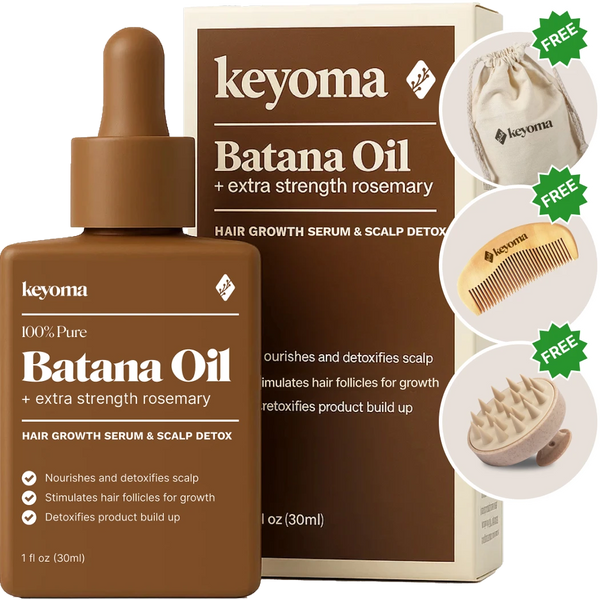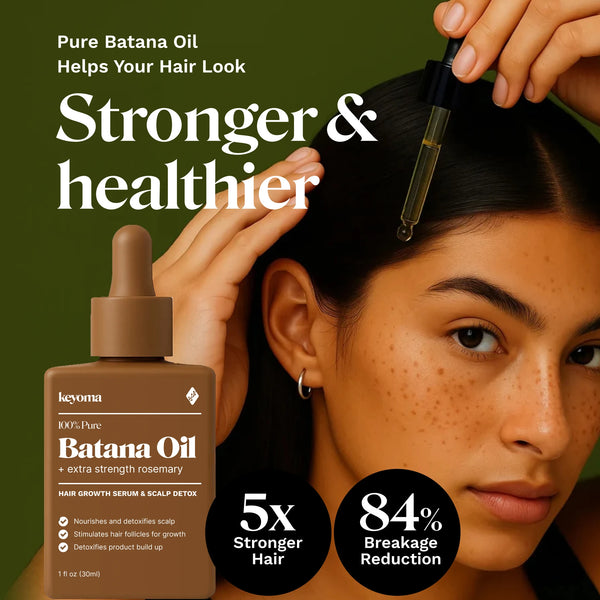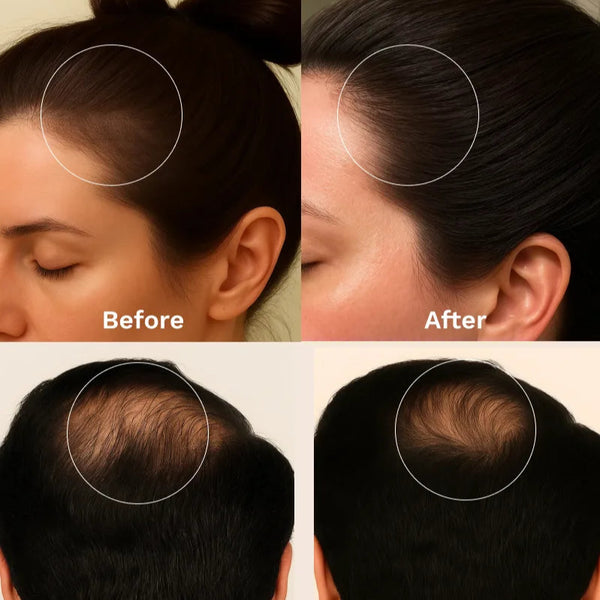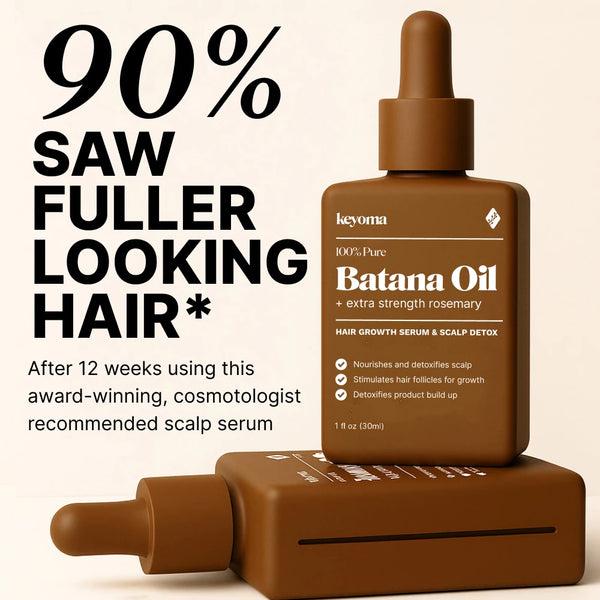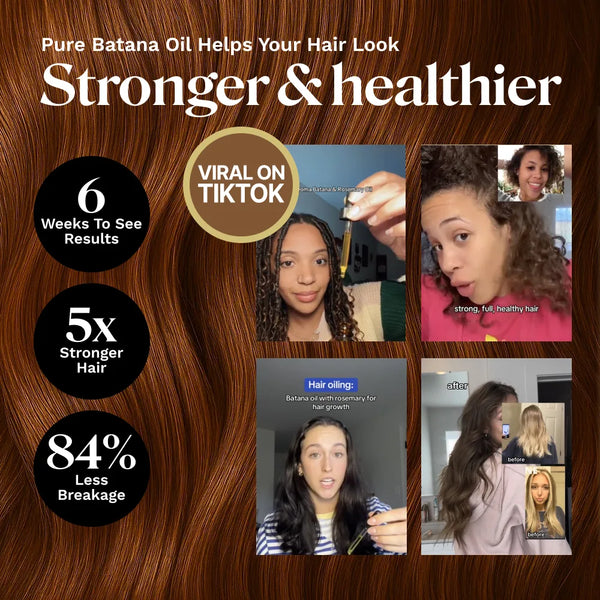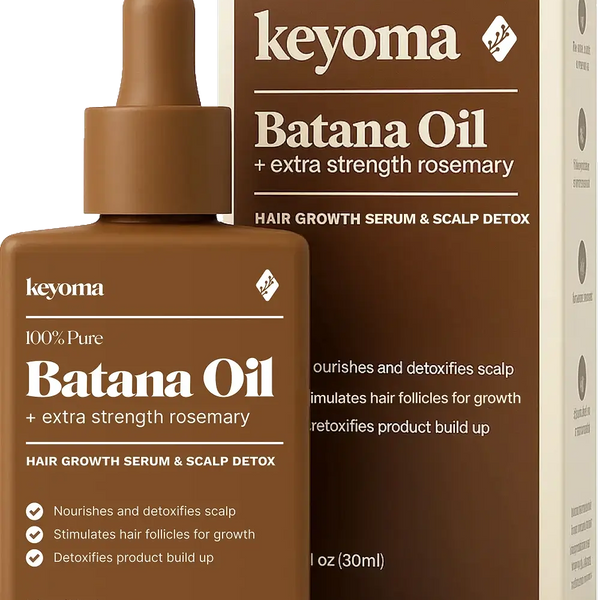In this article
When the weather warms up, you likely spend more hours outside. Time outdoors can lift your mood and support health. The tradeoff is higher UV exposure, which raises your chances of sunburn.
Sunscreen shields skin from ultraviolet (UV) rays. Your scalp is tougher to cover evenly, though, and that makes it easy to miss. Any hair length or density can still leave the scalp vulnerable to a burn.
Scalp sunburns hurt and can increase skin cancer risk. You can prevent them, and you can also soothe your scalp if you’ve already gotten burned.
Key Takeaways
-
Scalp sunburn occurs from UV exposure and increases skin cancer risk over time.
-
UV exposure dehydrates scalp, irritates skin, and weakens hair color, moisture, strength.
-
Consistent protection uses shade, SPF 30 or higher, hats, and UPF clothing.
-
During healing, cool water, cold compresses, aloe vera, hydrocortisone, and gentle care support comfort.
What is Scalp Sunburn?
A scalp sunburn is UV-related skin damage that forms on the scalp after sunlight exposure. It’s essentially the same as any other sunburn. Although scalp skin is a bit thicker than facial skin, it’s still susceptible to burning.
Why Your Scalp Gets Sunburned
Too much UV light causes sunburn. That light comes from the sun and from artificial sources like sunlamps. UVA reaches deeper layers and contributes to long-term damage, while UVB affects the surface and is the main driver of sunburn.
UV exposure injures skin cells. Your immune system reacts by increasing blood flow to those sites, creating inflamed, reddened skin called sunburn. You can burn on cool or cloudy days, and reflective surfaces like water, sand, and snow bounce UV back to the skin.
Symptoms of a Sunburned Scalp
A sunburned scalp looks and feels like any sunburn elsewhere on the body. Symptoms may include:
-
skin redness
-
skin warmth or feels hot to the touch
-
tenderness or scalp tenderness
-
scalp itching
-
tiny, fluid-filled blisters
With a more serious burn, you could also experience:
-
headaches
-
a fever
-
nausea or queasiness
-
tiredness
Early signs may show up within hours, though it can take 24 hours or more to see the full burn.
Impacts of Scalp Sunburn
UV radiation affects scalp health in both immediate and lasting ways. Knowing these effects helps you plan prevention and manage symptoms when they happen. Here’s how UV rays can influence the scalp:
Short-Term Effects
Without protection, the scalp can burn and become red, sore, itchy, and peel. The hairline is sensitive, so these symptoms can feel especially uncomfortable.
UV exposure can also dehydrate skin, leaving it dry, irritated, and flaky. That dryness can mimic dandruff and make the scalp feel more uncomfortable.
Long-Term Effects
Repeated UV exposure speeds visible aging, contributing to fine lines and wrinkles and reduced elasticity. On the scalp, this can look like thinner, less resilient skin.
UV radiation is a key risk factor for skin cancer, including basal cell and squamous cell carcinomas. Areas with thinning hair or bald spots are more exposed and therefore at higher risk.
How It Affects Hair Health
UV light can fade dyed and natural shades, leaving hair dull or changing its hair color over time. It can also strip natural oils, which makes hair dry, brittle, and more likely to split or break.
How to Prevent and Treat Scalp Sunburn
Even when you apply SPF on your scalp, reapplying is easy to forget, and it’s hard to spot early redness under hair. Prevention matters most, so wear SPF 30 or higher, a hat, and UPF clothing. We also reviewed ways to calm a sunburned scalp.
Always Use Sun Protection and Stay Out of the Sun
Dermatologists recommend shade, SPF 30 or higher, and protective hats and UPF clothing whether or not you’re currently sunburned.
Be extra consistent while your scalp and hairline heal after a burn. Both modern sunscreens and hats are easier to use now. Our favorite scalp sunscreens include brush-on powders that won’t leave roots greasy, and our editors’ favorite sun hats balance coverage with style.
Shower With Cool Water
The first step after a scalp or body sunburn is to slow the inflammatory cascade happening in skin.
Rinse the area with cool water, steering clear of ice, which can worsen a burn. If your scalp is affected, let a gentle, cool shower run over the area until the sting eases, usually for 5 to 20 minutes based on severity. Cool water on my crown eased the sting within a few minutes.
Use a Cold Milk Compress
Milk contains enzymes that may bind to skin and support recovery. Choose two percent or whole milk here, since the fat, protein, and pH can have calming, anti-inflammatory effects on skin.
Some dermatology sources suggest the cooling temperature does most of the work, not the milk itself, but many people still find it soothing.
To try it, soak a clean cloth in cool milk and press it gently to your scalp for about five minutes. You can repeat up to three times in one session; more than that isn’t necessary.
Apply Cold Compresses
Apply cool compresses a couple of times a day to ease burn pain. Avoid placing ice directly on skin. Compresses made with ice water offer relief, and you can add soy milk or mist it on for extra comfort. A close friend with a sensitive scalp felt calmer with cooler compresses.
Here’s a simple way to make one:
-
Fill a large bowl with ice and water, and add aloe or soy milk if you like.
-
Submerge several soft cloths so they cool and absorb the liquid.
-
Lay a cloth on the skin for about 20 minutes. Repeat as needed.
Soothe With Rosemary Oil
Rosemary may help calm an inflamed scalp after sun. Its key compounds (carnosic acid, carnosol, rosmarinic acid) show anti-inflammatory and anti-erythema activity in early models that look at UV-driven oxidative stress. Use it as an after-sun comfort step, not as SPF.
We suggest Keyoma Batana Oil with Rosemary. The rosemary adds antioxidants, and batana oil (Elaeis oleifera) provides vitamin-E family tocochromanols and emollients that help rehydrate and support the skin barrier during recovery. It’s a sensible comfort option, but it doesn’t replace sunscreen or hats.
Treat With Aloe Vera Gel
Aloe vera gel is a go-to for burns across the body. It hydrates and can help reduce inflammation. That mix of moisture and soothing action makes it a strong fit for sunburn care, and you can use it several times daily.
It may speed recovery, and the plant’s antioxidant and antibacterial effects are helpful for the scalp. If your hair is dense, part it where the scalp feels most tender before applying.
Put a small amount on your fingertip and gently work it into the burned area. Keep using it until symptoms settle. If you have little hair, massage gel across the scalp and wear a hat anytime you go outside.
In the first few days after a scalp or hairline burn, focus on treating the skin. Once tenderness fades, you can keep using aloe vera gel diluted with water so it doesn’t weigh hair down. A loose bun or ponytail with a cloth headband can hide emollients nicely.
Apply Hydrocortisone Cream
Dermatologists often recommend a 1% over-the-counter hydrocortisone cream once daily for scalp and hairline sunburn. Hydrocortisone helps with swelling, itch, and irritation.
Don’t use hydrocortisone longer than seven days unless your doctor advises it. If you don’t see improvement in 24 to 48 hours, contact a board-certified dermatologist for stronger options.
Skip Heat Styling
Skip heat tools while your scalp heals, including hot rollers, curling irons, straighteners, and blow dryers. Also avoid hot showers, since heat can increase discomfort and worsen damage.
Keep styles simple to prevent accidental peeling or irritation from brushing and combing. An air-dry cream on damp hair can give you a low-maintenance look.
Stick With Gentle Cleansers
Use mild cleansers and skincare while the skin recovers. Hold off on retinoids, acids, and medicated acne topicals, such as benzoyl peroxide washes. Avoid highly fragranced or medicated shampoos and leave-ins that might add irritation.
Drink More Water
Skin heals from the inside out, so rehydrating a sunburned scalp starts with drinking more fluids. Burns dehydrate the body, so add extra water and electrolytes each day.
Build a Gentle After Sun Scalp Routine with Keyoma
Scalp sunburn pain ramps up with heat and friction. It eases when you cool the skin, avoid hot tools, and stick with gentle products while it recovers. When tenderness settles and the skin is intact, seal damp roots with a light oil so hats and brushing glide smoothly.
Want comfort while you heal? Buy Keyoma Batana Oil with Rosemary directly from our website, or find it in our Amazon store.
Featured Product
100% Pure Batana Oil + Rosemary
↓Best Batana Oil to Buy↓
1 Month
Subscribe & Save
- 30-day supply delivered monthly $35
- 30% off for life $6
- Free haircare essentials kit $33
- Free custom wooden comb $10
- Free scalp massager $15
- Free eco-friendly travel bag $8
- 30-Day Money Back Guarantee
- Free Shipping
- Online portal for easy cancel, skip, or pause.
1 Month One Time Purchase
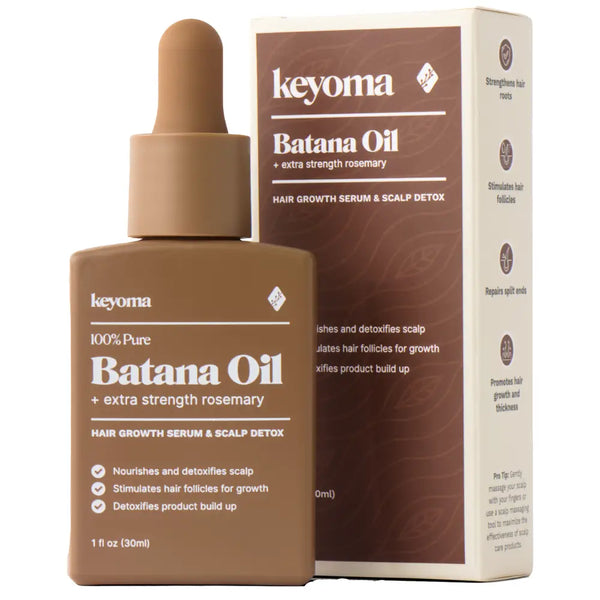
- 30-day supply $50
- 30% off for life $6
- Free haircare essentials kit $33
- Free custom wooden comb $10
- Free scalp massager $15
- Free eco-friendly travel bag $8

